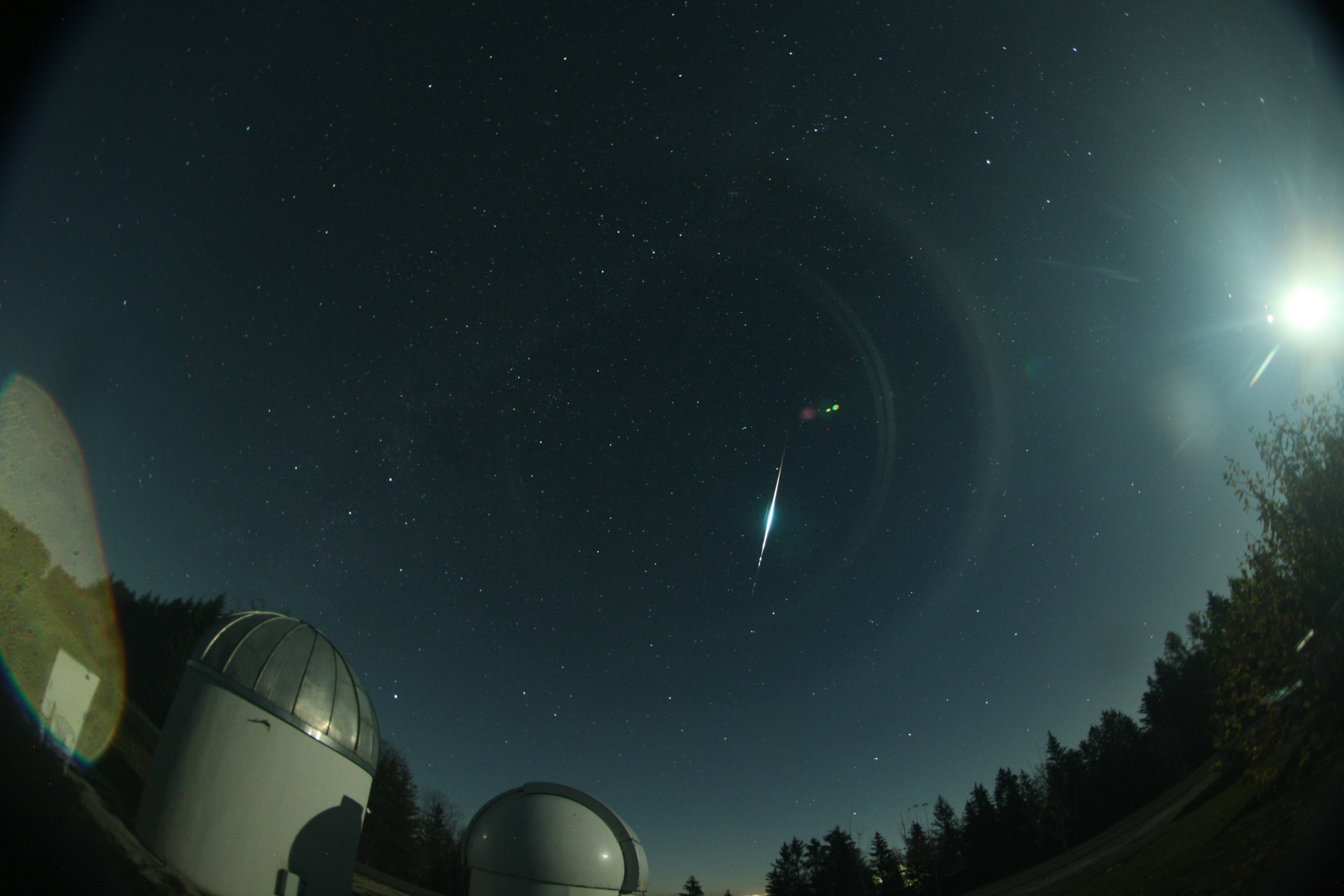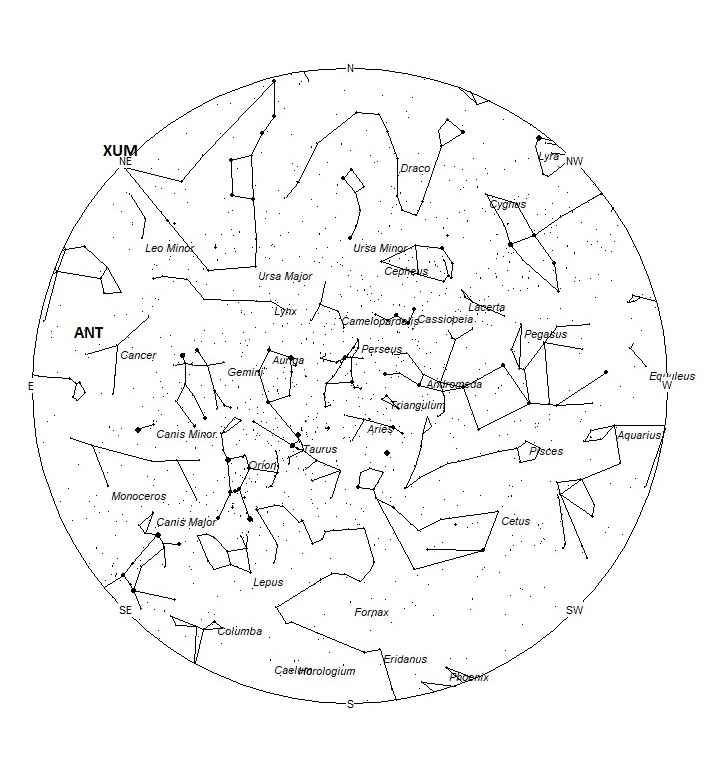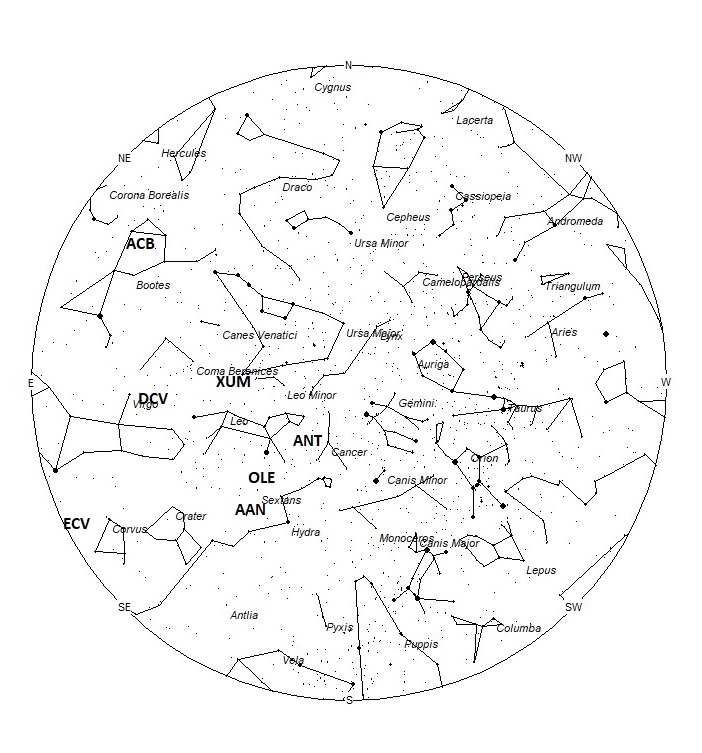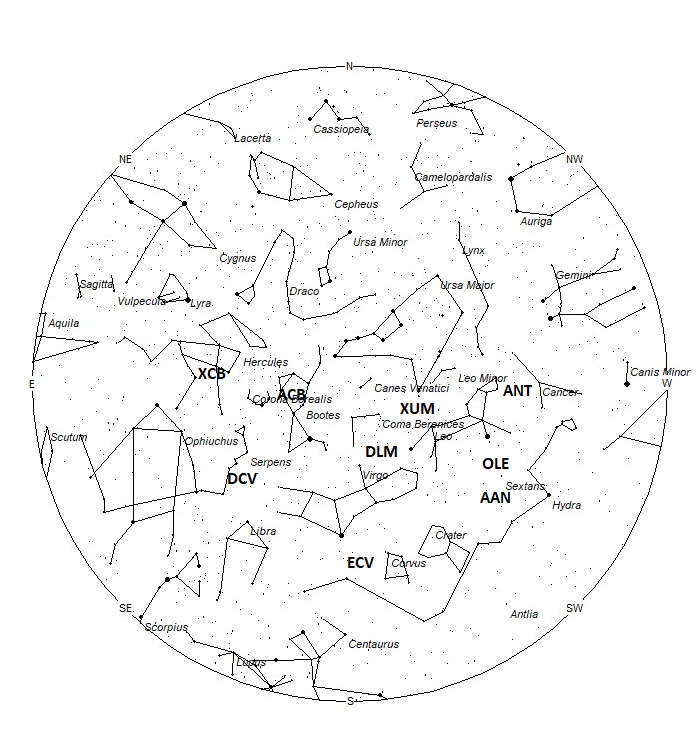 Erwin Filimon’s automated camera picked up this impressive fireball at 21:56 UT on 6 November 2020, from Weyregg am Attersee, Austria. For more on this fireball visit: https://fireball.amsmeteors.org/members/imo_view/event/2020/6365 Credit Erwin Filimon
Erwin Filimon’s automated camera picked up this impressive fireball at 21:56 UT on 6 November 2020, from Weyregg am Attersee, Austria. For more on this fireball visit: https://fireball.amsmeteors.org/members/imo_view/event/2020/6365 Credit Erwin FilimonDuring this period, the moon reaches its full phase on Friday January 29th. At this time, the moon is located opposite the sun, thus it will rise as the sun sets and set as the sun rises. This weekend the waxing gibbous moon will set during the early morning hours, leaving a small period of time free from interfering moonlight. The estimated total hourly meteor rates for evening observers this week is near 2 as seen from mid-northern latitudes and 3 as seen from tropical southern locations (25S). For morning observers, the estimated total hourly rates should be near 12 as seen from mid-northern latitudes (45N) and 12 as seen from tropical southern locations (25S). The actual rates will also depend on factors such as personal light and motion perception, local weather conditions, alertness, and experience in watching meteor activity. Evening rates are reduced during this period due to moonlight. Note that the hourly rates listed below are estimates as viewed from dark sky sites away from urban light sources. Observers viewing from urban areas will see less activity as only the brighter meteors will be visible from such locations.
The radiant (the area of the sky where meteors appear to shoot from) positions and rates listed below are exact for Saturday night/Sunday morning January 23/24. These positions do not change greatly day to day so the listed coordinates may be used during this entire period. Most star atlases (available at science stores and planetariums) will provide maps with grid lines of the celestial coordinates so that you may find out exactly where these positions are located in the sky. A planisphere or computer planetarium program is also useful in showing the sky at any time of night on any date of the year. Activity from each radiant is best seen when it is positioned highest in the sky, either due north or south along the meridian, depending on your latitude. It must be remembered that meteor activity is rarely seen at the radiant position. Rather they shoot outwards from the radiant, so it is best to center your field of view so that the radiant lies at the edge and not the center. Viewing there will allow you to easily trace the path of each meteor back to the radiant (if it is a shower member) or in another direction if it is sporadic. Meteor activity is not seen from radiants that are located far below the horizon. The positions below are listed in a west to east manner in order of right ascension (celestial longitude). The positions listed first are located further west therefore are accessible earlier in the night while those listed further down the list rise later in the night.
These sources of meteoric activity are expected to be active this week.
.
The Anthelion (ANT) radiant is active from a position located at 09:08 (137) +16. This position lies in eastern Cancer, 5 degrees southeast of the 4th magnitude star known as Asellus Australis (delta Cancri). This radiant is a very large oval some thirty degrees wide by fifteen degrees high. Activity from this radiant can appear from more than one constellation., This week these meteors can also be seen from western Leo and well as Cancer. There are several lists that have the delta Cancrids currently active, but we include them with the Anthelions as the celestial positions overlap. The position listed here is for the center of the radiant. This radiant is best placed near 01:00 Local Standard Time (LST) when it lies on the meridian and is highest in the sky. Rates at this time should be near 2 per hour as seen from the northern hemisphere and 1 per hour as seen from south of the equator. With an entry velocity of 30 km/sec., the average Anthelion meteor would be of slow velocity.
The alpha Antliids (AAN) were discovered by D. P. Galligan and W. J. Baggaley by using the Advanced Meteor Orbit Radar in New Zealand*. This very weak display is active from January 20 through February 10. There are two weak maximums occurring near January 26 and February 1. On January 26, the radiant lies at 10:09 (152) -07. This position lies in central Sextans, 7 degrees south of the 4th magnitude star known as alpha Sextantis). I’m not certain why these meteors were called alpha Antliids as this position lies 20 degrees north of the constellation of Antlia. These meteors are best seen near 0200 LST when the radiant lies highest above the horizon. At 44 km/sec. the alpha Antliids produce meteors of medium velocity. Expected rates this week are less than 1 per hour no matter your location.
*Gary Kronk, Meteor Showers-An Annotated Catalog, 2nd Edition Page 45
The Omicron Leonids (OLE) were discovered by Damir Šegon and the Croatian Meteor Network team based on studying SonotaCo and CMN observations (SonotaCo 2007-2011, CMN 2007-2010). These meteors are active from December 16 through February 4. Maximum activity occurred on January 9th. The radiant is currently located at 10:11 (152) +07. This position lies in southwestern Leo, 5 degrees south of the 1st magnitude star known as Regulus (alpha Leonis). These meteors are best seen near 0200 LST when the radiant lies highest above the horizon. At 42 km/sec. the omicron Leonids produce meteors of medium velocity. Expected rates this week are less than 1 per hour no matter your location.
The January xi Ursae Majorids (XUM) were discovered by Japanese observers of SonotoCo based on video observations in 2007-2008. This shower is active from January 10-25, with maximum activity occurring on the 19th. The radiant is currently located at 11:29 (172) +31, which lies in southern Ursa Major, 3 degrees southeast of the 3rd magnitude star known as Alula Borealis (nu Ursae Majoris). These meteors are best seen near 04:00 LST when the radiant lies highest above the horizon. Hourly rates should be less than 1 no matter your location. These meteors encounter the atmosphere at 40 km/sec., which would produce meteors of average velocity.
The December Leonis Minorids (DLM) are a shower of long duration active from November 22 through February 10th. Maximum occurred near December 20th. The radiant is currently located at 12:48 (192) +14. This position lies in southern Coma Berenices, 4 degrees northwest of the 3rd magnitude star known as Vindemiatrix (epsilon Virginis). These meteors are best seen near 0500 LST when the radiant lies highest above the horizon. Current hourly rates are expected to be near less than 1 no matter your location. At 63 km/sec. the December Leonis Minorids produce mostly swift meteors.
The eta Corvids (ECV) were recently discovered by Sirko Molau and the IMO Video Meteor Network Team. This stream is active from January 16-29, with maximum activity occurring on the 22nd. The current position of the radiant is 12:53 (193) -18, which places the radiant in eastern Corvus, 5 degrees southeast of the 3rd magnitude star known as Gienah (gamma Corvi A). These meteors are best seen near 0500 LST when the radiant lies highest above the horizon. Current hourly rates would be less than 1 per hour no matter your location. At 68 km/sec. these meteors would be fast.
The alpha Coronae Borealids (ACB) were discovered by John Greaves using data from SonotoCo. Activity from this source spans from January 20 to February 10 with maximum activity occurring on January 27. The radiant is located at 15:11 (228) +31. This position lies in in eastern Bootes, 3 degrees southwest of the 3rd magnitude star known as Princeps (delta Bootis). These meteors are best seen during the last few hours before dawn, when the radiant lies highest in a dark sky. Current rates should be near 1 per hour as seen from the northern hemisphere and less than 1 as seen from south of the equator. These meteors encounter the atmosphere at 55 km/sec., which would produce meteors of medium-swift velocity.
The December sigma Virginids (DSV) is a source of long duration also discovered by John Greaves using the data of SonotaCo. This source is active from November 22 through January 25. Peak rates occurred near December 21st. The current radiant location is at 15:40 (235) -01, which places it in southwestern Serpens Caput, 3 degrees northwest of the 4th magnitude star known as mu Serpentis. Current hourly rates should be less than 1 no matter your location. These meteors are best seen during the last dark hour before dawn, when the radiant lies highest above the horizon in a dark sky. At 66 km/sec. the December Sigma Virginids would produce mostly swift meteors.
The xi Coronae Borealids (XCB) were discovered by Dr. Peter Brown and associates. These meteors are active from January 5-25 with maximum occurring near January 15. The radiant is currently located near 17:10 (258) +29, which places it in central Hercules, 2 degrees southeast of the 4th magnitude star known as epsilon Herculis. Hourly rates would be less than 1 per hour no matter your location. These meteors are best seen during the last dark hour before dawn, when the radiant lies highest above the horizon in a dark sky. At 46 km/sec. this source would produce meteors of medium velocity.
As seen from the mid-northern hemisphere (45N) one would expect to see approximately 8 sporadic meteors per hour during the last hour before dawn as seen from rural observing sites. Evening rates would be near 1 per hour. As seen from the tropical southern latitudes (25S), morning rates would be near 11 per hour as seen from rural observing sites and 2 per hour during the evening hours. Locations between these two extremes would see activity between the listed figures. Evening rates are reduced due to moonlight.
The list below offers the information from above in tabular form. Rates and positions are exact for Saturday night/Sunday morning except where noted in the shower descriptions.
| SHOWER | DATE OF MAXIMUM ACTIVITY | CELESTIAL POSITION | ENTRY VELOCITY | CULMINATION | HOURLY RATE | CLASS |
| RA (RA in Deg.) DEC | Km/Sec | Local Standard Time | North-South | |||
| Anthelion (ANT) | – | 09:08 (137) +16 | 30 | 01:00 | 2 – 1 | II |
| alpha Antliids (AAN) | Jan 26 | 10:09 (152) -07 | 44 | 02:00 | <1 – <1 | IV |
| omicron Leonids (OLE) | Jan 09 | 10:11 (152) +07 | 42 | 02:00 | <1 – <1 | IV |
| January xi Ursae Majorids (XUM) | Jan 19 | 11:29 (172) +31 | 40 | 04:00 | <1 – <1 | IV |
| December Leonis Minorids (DLM) | Dec 20 | 12:48 (192) +14 | 63 | 05:00 | <1 – <1 | II |
| eta Corvids (ECV) | Jan 22 | 12:53 (193) -18 | 68 | 05:00 | <1 – <1 | IV |
| alpha Coronae Borealids (ACB) | Jan 27 | 15:11 (228) +31 | 55 | 08:00 | 1 – <1 | IV |
| December Sigma Virginids (DSV) | Dec 21 | 15:40 (235) -01 | 66 | 08:00 | <1 – <1 | IV |
| xi Coronae Borealids (XCB) | Jan 15 | 17:10 (258) +29 | 46 | 09:00 | <1 – <1 | IV |
 American Meteor Society
American Meteor Society



On Jan. 24th 2021 I saw what I think was a shooting star at approx 5:02 a.m. in Tarzana, CA
Just want to extend my gratitude your way. I always look forward to these emails, but this piece was exceptionally well communicated. I have so many lines highlighted to go back and further my knowledge base. While still I have digested a huge amount of content.
I’ll be looking up the newly published book, and tip my hat to you, Bob!